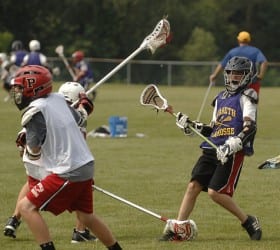Keep Score to Raise the Intensity at Practice.
We go to a lot of youth and high school lacrosse practices where the players are all standing in line, or just jogging through line drills, throwing lazy, arching passes. It's painful to watch. One way to inject some intensity and competitiveness into any practice is to keep score. Keeping score can make any part of practice literally "count for something"- goals, ground balls, turnovers, Clears, etc. can all be counted as points somehow.
Create a score-keeping system for some or all of your drills and games and let your players compete in every rep. Now it's a "game" instead of a "drill". Keep it simple and keep it fun. Ask your players to keep score for their team. This encourages them to be more attentive and involved in your activities.
 Keeping score rewards whatever specific behavior you want to focus on- catching passes, picking up loose balls, Clearing, scoring, etc. Success is a habit. Get your players started on a winning streak at practice, so that they know what winning feels like. Get them in the habit of doing the little things that result in winning games.
Keeping score rewards whatever specific behavior you want to focus on- catching passes, picking up loose balls, Clearing, scoring, etc. Success is a habit. Get your players started on a winning streak at practice, so that they know what winning feels like. Get them in the habit of doing the little things that result in winning games.
Winning is not the important part of all this. It is simply a measurement process for what is and is not working. It is the effort, success and positive recognition and reinforcement that comes with winning that matters. If you have four or five different segments to practice, every player is likely to be on a winning team more than once.
Everybody likes praise and recognition and High Fives. Nobody likes to lose. We still tell our wives and girlfriends how many goals we score at practice, and we're grown-ups.
Here are just some simple examples or suggestions:
- Split your team into pairs or groups of three. Give a point to the group that can make the most quick stick passes in one minute, or that can pick up the most ground balls (GB's) in one minute, or that can catch left, roll outside away from pressure and throw right the most times in one minute, etc., etc.
- If your drill starts with a Face Off or a loose ball from Coach, give one point for winning loose balls.
- Give one point for causing a turnover. If a Defender causes a turnover and wins the GB, that's two points for that guy. Just imagine how hard he's going to try in his next rep. See, Defense wins games too!
- Give one point every time the Defense keeps the Offense from scoring for thirty seconds or one minute. Don't let your team give up goals at the end of a period!
- If you are playing at even strength in your drill, 3-on-3 or 4-on-4 for example, make goals worth two points, one point for Clearing. Putting the ball in the back of the net is harder than getting the ball past the midfield line, so it should be worth more.
- Give the Defense a way to win too. Clearing the ball in a game gets the ball to the Offense, and that can definitely help you win, so Clearing should be worth something.
- If the Offense automatically starts with the ball in your drill, include a Clear after a save or goal so the Defense gets to handle the ball too, and get back one point for Clearing successfully.
- Any time one team has an extra man, like the 4-on-3 Fast Break Drill or 5-on-4 Slow Breaks, or if you are playing the Numbers Game for example, goals should only be worth one point. Your players should score almost every time they are handed a clear extra-man advantage. If the Offense turns the ball over, throws it out of bounds, or the Goalie makes a save, give one point to the Defense. Reset the drill and start again. The point of this drill is not to make the Defense work on Clearing when they are down a man, so why waste time doing it. This can also help your team understand how critical these extra-man opportunities are, and that you need to cash in on them if you want to be good!
 This also creates low-pressure situations on each player to perform well in every rep, every drill, every game. Young athletes need to know what this pressure feels like before they get in a game situation. It also creates the opportunity for kids to practice giving and receiving positive encouragement with their teammates, how to overcome adversity, control their emotions in defeat, etc., etc.
This also creates low-pressure situations on each player to perform well in every rep, every drill, every game. Young athletes need to know what this pressure feels like before they get in a game situation. It also creates the opportunity for kids to practice giving and receiving positive encouragement with their teammates, how to overcome adversity, control their emotions in defeat, etc., etc.
Teaching kids resiliency- how to recover from mistakes, defeat, fights, arguments, loss, etc., is what youth sports is really all about.
Trevor Tierney (Denver/Team USA) wrote a great article on this recently.
You could also time your drills for your players' age and attention span. Play each game for push ups, up-downs, hill sprints, full-field sprints, anything they won't want to do. Make it competitive. Invite the winners to run with the rest of the team. You could even run too, Coach! Or make the losing team pick up all the balls, cones and goals after practice.
Just remember to keep score, keep time and keep it fun! Try it and tell us how it works for your team.


